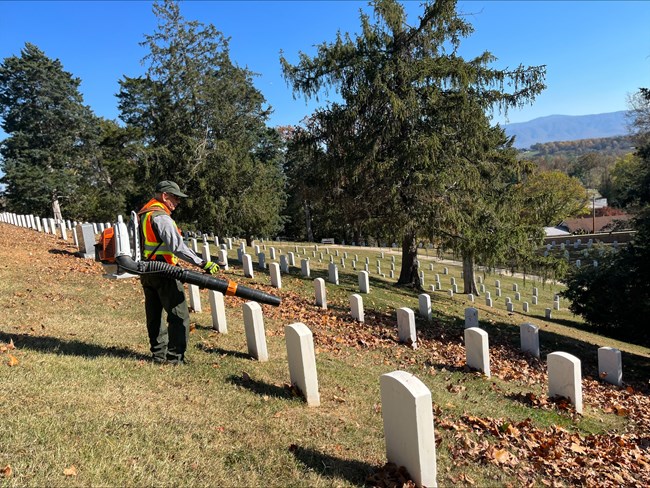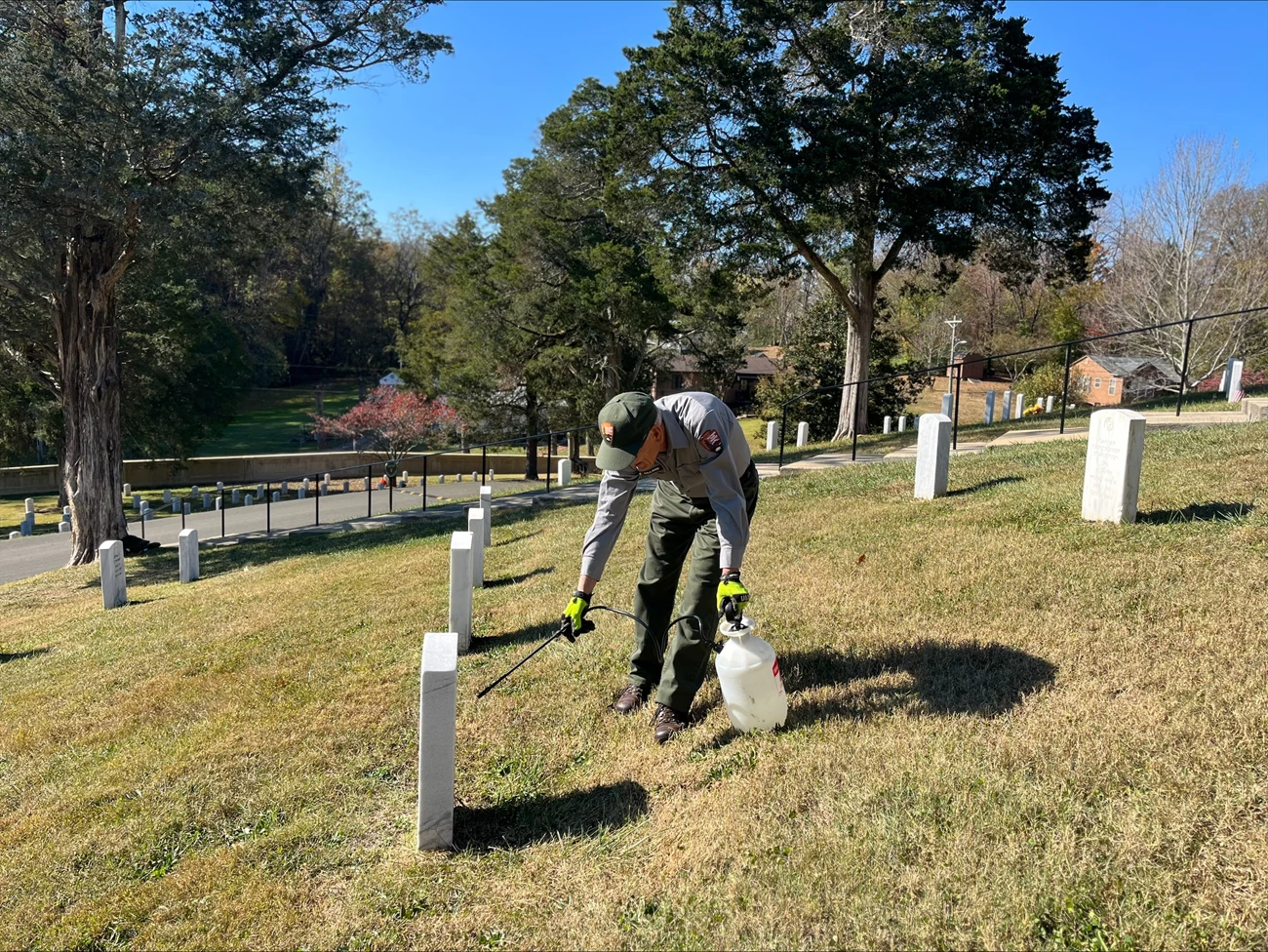Last updated: November 11, 2023
Article
Caring for Commemoration, Honoring Veterans in the National Park Service
AJ Gilland, Maintenance Worker, Andrew Johnson National Historic Site

Can you share a bit about your military service and what led you to join the National Park Service?
I served three years of active duty and four years as a reserve in the United States Army 1973-1980. My military job classification was battery clerk. I served in this capacity at Headquarters Battery, First Battalion, 18th Airborne Corps Artillery at Fort Liberty, North Carolina until 1976.
In 2016, I contacted the Andrew Johnson National Historic Site and applied for a park guide seasonal position. I was fortunate enough to be selected and continued working in Interpretation until an opening for a seasonal maintenance worker became available the following year. I continued working at ANJO as a seasonal maintenance worker my second year. There was not an opening for a maintenance worker in 2018, but a museum technician position became available, so I applied and was accepted for that position. I served as museum technician until 2019 when another maintenance worker position opened. I applied for that position, was accepted, and have continued working in that capacity.
How did your military experience prepare you for a role at the National Park Service, especially in terms of skills and values?
While in the military, I met and worked with other people from all over the country. I learned how to collaborate to attain and achieve common goals even though many of my fellow soldiers came from very different backgrounds than my own. The military helped me better understand the idea of making compromises for the betterment of the entire organization. I improved and enhanced my interpersonal communication skills, and I learned to better respect the opinions of others, even though those opinions were sometimes very different than my own. I learned how to be punctual, reliable, and more self-motivated. These are some of the skills that have carried over from my military service to the National Park Service.
Many veterans bring a diverse set of skills to their work. Can you highlight a particular skill or experience from your military service that you find especially valuable in your current role?
The military certainly broadened my understanding of the concept of multiculturalism. The US Army is a very diverse organization, and as a result, I had the opportunity to work with people from all over the world. Understanding and appreciating others from different areas and cultures was one of the most important skills that I acquired in the military that has carried over to my experience with the National Park Service.
What preservation projects have you been involved in at the National Park Service, and how do you feel your work contributes to the broader mission of the NPS?
Since beginning my work with ANJO, I have had the opportunity of being involved in several preservation projects. As an interpreter, I had the chance of sharing information about the life of and times of our seventeenth President, Andrew Johnson. As a museum technician, I had the opportunity of organizing, labeling, cataloging, and relocating hundreds of artifacts that were moved from the park to the Cultural Preservation Center which is better equipped to house historical artifacts and documents. As a maintenance worker, I have been involved in cemetery headstone alignment projects, grave restoration, and regular grave maintenance work including mowing and weed eating operations and applying D-2 biologic solution to headstones to keep them clean and well maintained. My work contributes to the broader mission of the NPS by providing information and service to the park that will benefit generations to come and provide everyone with the same opportunity to experience and appreciate our National Parks.

Can you share a particularly proud or rewarding moment you’ve experience while working on a preservation project?
As a veteran, the most rewarding aspects of my job include receiving positive comments and feedback from the public and community members regarding the work we perform in the National Cemetery. In recent years, we have made several improvements including installing handrails, replacing and resetting headstones, resurfacing roads around the cemetery, restoring and patching the wall around the cemetery, removing unsightly trees, planting new trees, and installing section signs and more lighting in the cemetery. All these improvements have enhanced the aesthetic quality of the cemetery, and both visitors and residents have commented on the improved appearance. So, it truly is an honor to be able to help care for the final resting place for my fellow veterans.
The NPS has a diverse range of roles. Can you describe how your current position allows you to apply different aspects of your background and expertise?
My current position as a maintenance worker allows me to apply different aspects of my background and expertise in several ways. Like my military experience, the National Park Service has provided me with the opportunity of meeting and working together with a broad range of people. In addition to my regular coworkers, I have worked with Youth Conservation Corps high school students, individuals from the Historic Preservation Training Center, and American Conservation Experience.
Preservation projects often have a positive impact on local communities. How do you see your work contributing to community well-being?
The Andrew Johnson National Cemetery is located near the center of downtown, and the town and county has very strong traditional ties to the United States military. Veterans Memorial Park is less than a mile from the park, and because of this proximity, veterans and other community members regularly pass by the cemetery and other components of ANJO. When community members pass by the cemetery and other components of the park and see that the grounds are aesthetically pleasing and well maintained, it makes them proud to have National Park Service site in their hometown. The Wreaths Across American program brings together community members to help place and remove the wreaths from gravesites. The park also offers other opportunities for community members to take part in park activities such as the flag retirement activity on Flag Day, and students from local colleges and high schools participate in and assist with headstone cleaning and other park-related activities that make them feel that they are a part of the park and that the park is a part of the larger community.
As we approach Veterans Day, what would you like the public to know or understand about the contributions of veterans working in the National Park Service?
I would like the public to know and better understand that veterans working in the National Park Service are committed to the NPS mission just as were committed to our mission of serving our country while in the military. Yes, it is a job, but it is so much more than that! It’s a privilege and an honor to be able to care for the final resting place of my fellow veterans. For me personally, serving in the National Park Service is picking up from where I left off in the military. To a very large degree, I am still serving my country by serving fellow veterans who have paid the ultimate price with their service.
